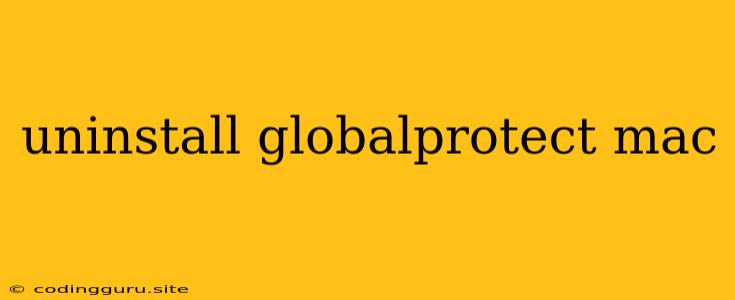How to Remove GlobalProtect from Your Mac
GlobalProtect is a VPN solution widely used by businesses to secure their employees' internet connections. While it offers robust security, sometimes you might need to uninstall it from your Mac for various reasons. Whether you're switching jobs, experiencing issues with the software, or simply no longer require it, this guide will walk you through the steps to remove GlobalProtect effectively.
Understanding the Uninstall Process
Uninstalling GlobalProtect from your Mac isn't as straightforward as dragging its icon to the trash. It involves a series of steps to ensure a clean removal, preventing any residual files or configurations from hindering future software installations or causing system instability.
Step-by-Step Guide to Uninstall GlobalProtect
- Quit GlobalProtect: Before initiating the removal process, ensure that GlobalProtect is completely closed. This can be done by right-clicking on its icon in the menu bar and selecting "Quit GlobalProtect."
- Uninstall the Application:
- Navigate to Applications folder in your Finder.
- Locate the GlobalProtect application, usually named Palo Alto Networks GlobalProtect.
- Drag the GlobalProtect application to the Trash.
- Remove the Configuration Files:
- Open Finder and navigate to Go > Go to Folder.
- Type ~/Library/Application Support/Palo Alto Networks/GlobalProtect and press Enter.
- Delete the entire GlobalProtect folder.
- Delete the Preferences Files:
- In the Go to Folder window, type ~/Library/Preferences/com.paloaltonetworks.globalprotect.plist and press Enter.
- Delete the com.paloaltonetworks.globalprotect.plist file.
- Remove the Logs:
- In the Go to Folder window, type ~/Library/Logs/GlobalProtect and press Enter.
- Delete the entire GlobalProtect folder.
- Empty the Trash: After deleting the necessary files and folders, right-click on the Trash icon and select Empty Trash.
Important Considerations
- Administrator Access: You might require administrator privileges to delete certain files and folders during the process.
- Backup: Before proceeding, consider backing up your Mac to ensure you have a copy of your data in case anything goes wrong.
- Network Connection: During the process, you might need to disconnect from the network if the GlobalProtect software is still active.
Troubleshooting
If you encounter any difficulties or error messages during the removal process, you can try the following:
- Reboot your Mac: Sometimes, restarting your Mac can resolve minor issues that hinder uninstall processes.
- Use an Uninstaller Tool: Several third-party uninstaller tools are available, such as AppCleaner or CleanMyMac. These tools can help remove stubborn applications and associated files.
- Contact Support: If the problem persists, contact your IT department or Palo Alto Networks support for assistance.
Conclusion
Removing GlobalProtect from your Mac involves a thorough process of deleting the application and associated files. By following these steps carefully, you can ensure a complete and clean removal, freeing up space on your hard drive and eliminating any potential conflicts with other software. Remember to always backup your data before performing any system changes.
